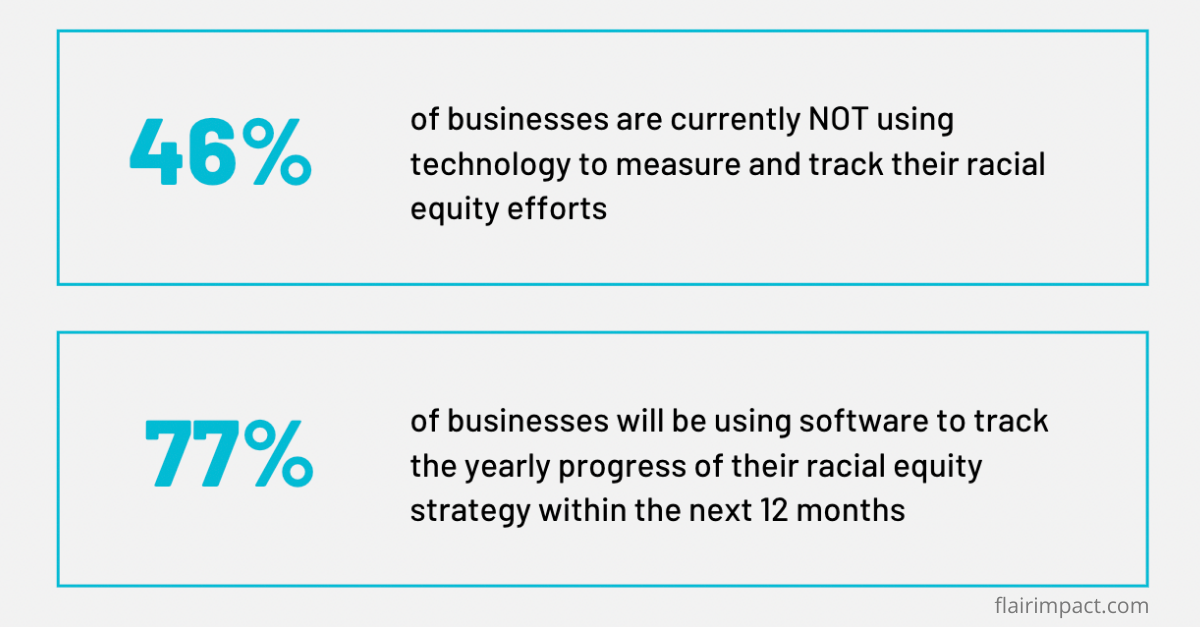Getting started with racial equity: how to turn intent into corrective action
Workplace racial equity is both a moral and a business imperative. Equitable businesses are more profitable businesses, after all.
But don’t just take our word for it! A number of surveys — including the now-famous report from McKinsey — have shown that improved diversity within an organisation is linked to improved financial performance. One study found that racial equality was linked to 58% higher revenue, among a number of other value-adding benefits.
When organisations tackle racial inequity in the workplace, they also find it easier to recruit and retain talent, secure investment and build a positive brand image that attracts more customers.
This is something that UK business leaders seem to have taken on board. According to FLAIR’s research, an impressive 79% said that racial equity is a priority for their organisation.
But how many organisations are making a success of their racial equity strategy? How many are producing real, anti-racist change within their workplaces?
Findings from our Racial Equity in the Workplace report provide lots of food for thought. They help us to see where organisations are going wrong — and what both they and you can do to tackle racial inequity in the workplace more effectively.
Lead from the top

We found that only 37% of racial equity strategies are led by the leader of an organisation — that’s the CEO, founder or owner. Instead, racial equity strategies are commonly led by HR teams or DE&I appointments. However, to achieve systemic change, the whole company — not just a dedicated DE&I department — has to be accountable for and committed to change.
Racial equity has to be built into the ethos of an organisation. This all starts with strong leadership and an all-encompassing racial equity strategy. Anti-racist leadership acts to motivate change in recruitment and management processes, as well as organisational culture.
All employees can be treated equitably and can come to thrive within an organisation when leaders are clear on their anti-racist ambitions and encourage wholesale organisational change.
Choose your metrics carefully
How do you measure the success of your racial equity strategy? If you make diversity your key metric, this is problematic.
Achieving diversity should not be the sole goal of your racial equity strategy. Of course, racial diversity matters. But it’s just one piece of the puzzle.
There are other, crucial components of racial equity including inclusion, racial awareness and the prevalence of racist behaviours. It’s these metrics that demonstrate your ability to not only hire diverse talent, but to also cultivate an anti-racist culture that diverse talent wants to be part of long term.
Work to measure all aspects of racial equity to get a true picture of your organisation’s performance and to identify areas that require extra attention.
Utilise technology to measure success

An encouraging 77% of organisations plan to use software to track the year-on-year progress of their racial equity strategy. And yet 46% of the business leaders we surveyed have yet to put these plans into action. Almost half of organisations are missing out on the benefits DE&I technology provides.
Technology has transformed how businesses understand, measure, and track the effectiveness of their business plans.Applying the same analytical approach towards racial equity will ensure that leaders deliver ROI on their racial equity budgets more quickly and drive material change.
When you use technology to track the effectiveness of your racial equity strategy, you increase the reliability of your metrics and your understanding of what those metrics actually mean. When you have a clear idea of where your organisation currently stands, it’s easier to plan a route forward and to see how far you’ve come.
This helps to ensure a better ROI on your racial equity budget. UK businesses spend £5.5 billion each year on DE&I initiatives. However much your organisation is contributing to that figure, you need to know that your investment is producing the desired results.
Use data to steer corrective action
Data and technology can also help you to craft a successful plan of racial equity action.
16% of the organisations we surveyed said they are prioritising anti-bias training to advance racial equity, making it the most popular anti-racist action reported in our survey. Yet this goes against decades of social science research that pointed to a simple truth — you won’t get managers on board with your racial equity strategy solely with rules and re-education.
While diversity training can be used as part of a racial equity strategy, it’s not the magic cure that many organisations seem to think it is. But in the absence of data insight, businesses tend to simply mirror the actions of others, not really knowing how to tackle the root cause of racial bias in their organisation or the effectiveness of their initiatives.
Use data to understand problems and root causes — and to challenge assumptions. This will give you the insight you need to tailor corrective action to the needs and realities of your own company. The end result? More effective and successful racial equity strategies.
Read FLAIR’s full Racial Equity in the Workplace report
While many organisations believe they are making significant progress, very few companies have quantifiable approaches to achieving intentional inclusion within their workplaces. Before an organisation can quantify what the right action to take is, it must use data analytics to identify the root cause of the problem and then take targeted action based on the results.
To find out how UK business leaders are tackling racial equity and our recommendations for improving your organisations DE&I performance, download our latest Racial Equity in the Workplace report here.








